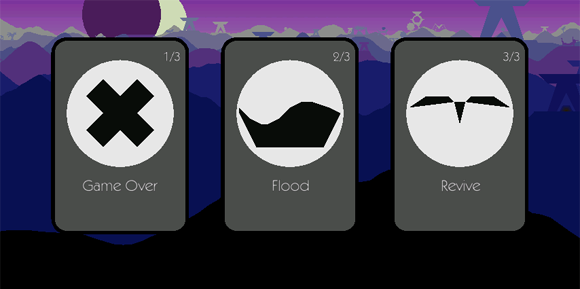After explaining the build-blocks of Silent Totems in my last three Tuesday-Developer-Diary Entries (part 1, part 2,part 3), its now time to show how all comes together.
Initially the game was planned to be about the game world, its strangeness, and a little classic-adventure-like unfolding story. This would have included setting up puzzles in a linear order (get A, bring to B, help C, solve D, talk to E, get key F, get back to G, open door H, …), which is nice to tell as a story but brings some difficulties into the development process than most often turn into difficulties for the player.
In this dev-diary entry I will try to explain the difficulties and what solution we came up with for Silent Totems.

Task Cards: ever collected and kept track of solved and unsolved puzzles in a game?
Linear ordered puzzles result in hefty balancing requirements. In other words: you should not present a really difficult puzzle early, and easier ones later due to at least two causes: First, It bores people to get the easy ones after they struggled so long with the early difficult one. And second many people never will make it through the game, nor even to the later presented easier ones when they will not be able to overcome the early difficult one. So all they will see are the initial easier ones up to the first that is just to difficult for them.
When Krystian, Julia and I (Daniel) designed Excit, the puzzle levels where mostly created by me on a day by day basis, without thinking about the difficulty. Then later we three developers and some friends would playtest the levels so that we got indications of the difficulty of each level. And thus simply ordered them from easier to harder, so that the game got balanced.
But its not easy to do this with puzzles that are (to be) based on a story and thus are not easily exchanged or re-ordered. Most game developers end up in re-creating sub-puzzles, puzzle-situations and even whole levels over and over.
For a small two man part-time team this is most often out of the question – if you want to stay “in time & in budget”. (in budget means here: finish a game in less than 1000 man hours, and thus spent less than 15.000 usd for developing a game. with a high chance that the game will most often only sell to 1000 customers for 3 usd, where after merchant fares and taxes a maximum of 1.5 usd remains). (for Europeans this is 10.000 euros, 2 euro per game, 1 euro remains)
So putting thoughts about money aside – and getting back to what’s fun about game development: Ordering puzzles is a well known concept, still it does most often not give best results. People think different, and thus solve puzzles quite different. Which results in some people finding the right puzzle order to be A,B,C while others find B,A,C should be the order and even some find it to be easiest to even go backwards with C,B,A.
A little bit research and experience with players around me resulted in my concept of map-based puzzle games, like i used it in Princess Nuriko. You solve a level, return to a 2d map and levels adjacent to the last one solved can now be accessed. The levels are still loosely ordered from easy to hard, but if players struggle with some levels, they have always some others with different difficulties they can solve first.
Yann and my personal taste was that this may be a great idea for abstract puzzle games, but would hurt the adventure world feeling of our vision of Silent Totems. So again this wasn’t the way to go. Instead the game still centers on the puzzles and player interactions with the strange gameworld, but we exchanged the idea of a storyline driven gameplay against unordered puzzles.
We also recognised that a full-fledged storyline might not make sense for the intended target audience (smartphones, low price point, short play sessions) and we would not have the resources (time) to create a story based adventure with linear puzzles – neither was it one of our personal interests, as I love board game like puzzles and videogames while Yann is a great fan of the classic Yoda Stories – Desktop Adventures.
So our unordered puzzles are all available in parallel. Its up to the player to experiment with puzzle elements available everywhere and find out how things work together. We have more or less 3 levels of difficulty: more trivial tasks given by characters, some harder puzzles that help / extend the results while fulfilling the tasks and very hard puzzles that depend solely on the players puzzle solving intuition and/or sheer cleverness ![]()
All puzzles result in immediate feedback, either through a bit of story dialogues, visible effects and last but not least in fulfilling one of our Task Cards.
Task Cards are what you can see on the screenshot above, simple “collectible” cards, which feature all possible puzzle situations of our game. So if you solve a puzzle you will fulfill its Task Card. This will allow you to keep track of your progress regarding all puzzles possible in the game (its definitely more than the number 3 on this screenshot indicates ![]()
But additionally unfulfilled Task Cards will give you vague hints on what could be possible and present you some sort of carrot-on-a-stick, teasing you to experiment more with the games elements.






nice read, please keep up the diary!
(c: